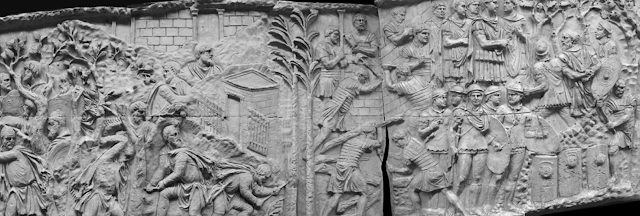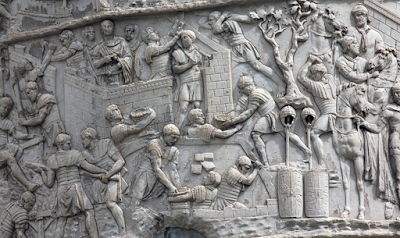 |
| Scenes 67 and 68 |
Empires often present a narrative that suggests that imperialism improves the daily lives of colonized peoples. This includes both the social conversion from barbarian to "civilization" that is often referred to as romanization, and the introduction of infrastructure and building practices that surpass the capabilities of the indigenous peoples, which included but were not limited to Roman roads and concrete. In essence, colonial powers believe that colonialism benefits the colonized and subjugated because the imperial powers "gift" them with superior culture and technology. The beginnings of this narrative can be found in Roman Imperial imagery. For instance, the Column of Trajan highlights the supposed superiority of Roman buildings. Scenes 11, 20, and 73 depict Roman soldiers constructing stone fortifications, and scene 43 shows captured Dacians being held behind a large stone wall. It is these stone buildings that set the Romans apart from their enemies. Further depictions of contrasting building practices are visible in scenes 67 and 68, which depict Dacians cutting down trees in a disorganized and rushed attempt to build defences, while the Romans build their stone fort with composed efficiency. It is this juxtaposition of building techniques and quality that highlights the superior engineering and training of the Roman military. Later constructions of colonial narratives from the early modern period to today have used this implied superiority of colonizing powers to suggest that the introduction of infrastructure and technology justifies the conquest and slaughter of the local populace. Furthermore, Romans did build roads and aqueducts in provinces following the conquest of the area, thereby improving the infrastructure of the local populace. However, there is no evidence that Romans used this "local betterment" to justify their conquest. They recognized that they benefited from these projects, as the roads allowed for the creation of prolific trade routes and facilitated the movement of the Roman legions to ensure the obedience of the subjugated peoples. While this particular colonial narrative is not necessarily a Roman creation, it is interesting to note the beginnings of a sense of superiority that was later used by modern imperial forces to justify the conquest and destruction of indigenous peoples.
 |
| Scene 11 |
 |
| Scene 20 |
 |
| Scene 73 |
 |
| Scene 43 |
Ferris, Iain. "The Hanged Men Dance: Barbarians in Trajanic Art." in Roman Imperialism and Provincial Art. Edited by Sarah Scott, and Jane Webster. New York: Cambridge University Press, 2003.
Johns, Catherine. "Art, Romanisation, and Competence." in Roman Imperialism and Provincial Art. Edited by Sarah Scott, and Jane Webster. New York: Cambridge University Press, 2003.
Kellum, Barbara. "Imperial Messages" in The Oxford Handbook of Roman Sculpture. Edited by Elise A. Friedland, Melanie Grunow Sobocinski, and Elaine K, Gazda. Oxford: Oxford University Press, 2015.
Lepper, Frank and Sheppard Frere. Trajan's Column: A New Edition of the Cichorius Plates. Gloucester: Alan Sutton Publishing, 1988.
Mattingly, David J. Imperialism, Power, and Identity: Experiencing the Roman Empire. Princeton: Princeton University Press, 2011.
Ulrich, Roger B. Trajan's Column in Rome. Accessed June 30, 2018. http://www.trajans-column.org/




No comments:
Post a Comment